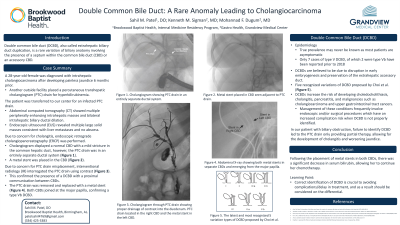Sunday Poster Session
Category: Biliary/Pancreas
P0063 - Double Common Bile Duct: A Rare Anomaly Leading to Cholangiocarcinoma
Sunday, October 22, 2023
3:30 PM - 7:00 PM PT
Location: Exhibit Hall

Has Audio

Sahil M. Patel, DO
Brookwood Baptist Health
Birmingham, AL
Presenting Author(s)
Sahil M. Patel, DO1, Kenneth M. Sigman, MD2, Mohannad F. Dugum, MD2
1Brookwood Baptist Health, Birmingham, AL; 2Gastro Health, Grandview Medical Center, Birmingham, AL
Introduction: This case report presents a case of early onset cholangiocarcinoma in a patient with type Vb double common bile duct (DCBD), a rare variation of biliary anatomy. Between 2007 and 2018, only 7 cases of type V DCBD have been reported, of which only 2 cases were type Vb. DCBD has been associated with an increased risk of developing choledocholithiasis, cholangitis, pancreatitis, and malignancies, such as cholangiocarcinoma and upper gastrointestinal tract cancers. This case highlights the need for thorough evaluation of the biliary anatomy in young patients with cholangiocarcinoma, as the presence of biliary anatomy variations can lead to incomplete resolution of biliary obstructions.
Case Description/Methods: A 28-year-old woman, diagnosed with metastatic cholangiocarcinoma 6 months earlier, was transferred for evaluation of a presumably infected percutaneous transhepatic cholangiogram (PTC) drain. The PTC drain was originally placed for persistently elevated serum bilirubin, which the PTC drain failed to resolve. Initial CT scan and EUS showed masses in the liver consistent with metastases and no evidence of an abscess. Due to concern for cholangitis, ERCP with cholangiogram was performed, which demonstrated a mild stricture in the common hepatic duct while also showing the PTC drain in an entirely separate ductal system. Due to concern for the misplacement of the PTC drain, the IR team interrogated the drain using contrast and revealed the presence of a DCBD with a single proximal communication, confirming type Vb. Two mental stents were placed in each CBD, relieving the biliary obstruction. This led to a significant decrease in serum bilirubin levels and allowed for continuation of the patient’s chemotherapy regimen.
Discussion: There are 5 variation types of DCBD, with type Vb being the rarest. The true prevalence of DCBD may never be known because most individuals are asymptomatic. Most new cases of DCBD are found incidentally during management of other conditions, such as choledocholithiasis, cholangitis, and cholangiocarcinoma. As management frequently warrants endoscopic and/or surgical procedures, correct identification of DCBD is crucial as it can lead to complications when undiagnosed. In this case, the patient’s undiagnosed DCBD led to 6 months of only partial therapy of biliary obstruction, allowing for the development of cholangitis and continued increase in serum bilirubin levels.
Disclosures:
Sahil M. Patel, DO1, Kenneth M. Sigman, MD2, Mohannad F. Dugum, MD2. P0063 - Double Common Bile Duct: A Rare Anomaly Leading to Cholangiocarcinoma, ACG 2023 Annual Scientific Meeting Abstracts. Vancouver, BC, Canada: American College of Gastroenterology.
1Brookwood Baptist Health, Birmingham, AL; 2Gastro Health, Grandview Medical Center, Birmingham, AL
Introduction: This case report presents a case of early onset cholangiocarcinoma in a patient with type Vb double common bile duct (DCBD), a rare variation of biliary anatomy. Between 2007 and 2018, only 7 cases of type V DCBD have been reported, of which only 2 cases were type Vb. DCBD has been associated with an increased risk of developing choledocholithiasis, cholangitis, pancreatitis, and malignancies, such as cholangiocarcinoma and upper gastrointestinal tract cancers. This case highlights the need for thorough evaluation of the biliary anatomy in young patients with cholangiocarcinoma, as the presence of biliary anatomy variations can lead to incomplete resolution of biliary obstructions.
Case Description/Methods: A 28-year-old woman, diagnosed with metastatic cholangiocarcinoma 6 months earlier, was transferred for evaluation of a presumably infected percutaneous transhepatic cholangiogram (PTC) drain. The PTC drain was originally placed for persistently elevated serum bilirubin, which the PTC drain failed to resolve. Initial CT scan and EUS showed masses in the liver consistent with metastases and no evidence of an abscess. Due to concern for cholangitis, ERCP with cholangiogram was performed, which demonstrated a mild stricture in the common hepatic duct while also showing the PTC drain in an entirely separate ductal system. Due to concern for the misplacement of the PTC drain, the IR team interrogated the drain using contrast and revealed the presence of a DCBD with a single proximal communication, confirming type Vb. Two mental stents were placed in each CBD, relieving the biliary obstruction. This led to a significant decrease in serum bilirubin levels and allowed for continuation of the patient’s chemotherapy regimen.
Discussion: There are 5 variation types of DCBD, with type Vb being the rarest. The true prevalence of DCBD may never be known because most individuals are asymptomatic. Most new cases of DCBD are found incidentally during management of other conditions, such as choledocholithiasis, cholangitis, and cholangiocarcinoma. As management frequently warrants endoscopic and/or surgical procedures, correct identification of DCBD is crucial as it can lead to complications when undiagnosed. In this case, the patient’s undiagnosed DCBD led to 6 months of only partial therapy of biliary obstruction, allowing for the development of cholangitis and continued increase in serum bilirubin levels.
Disclosures:
Sahil Patel indicated no relevant financial relationships.
Kenneth Sigman indicated no relevant financial relationships.
Mohannad Dugum indicated no relevant financial relationships.
Sahil M. Patel, DO1, Kenneth M. Sigman, MD2, Mohannad F. Dugum, MD2. P0063 - Double Common Bile Duct: A Rare Anomaly Leading to Cholangiocarcinoma, ACG 2023 Annual Scientific Meeting Abstracts. Vancouver, BC, Canada: American College of Gastroenterology.
